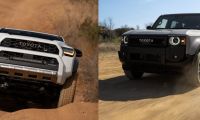On a recent Reddit r/Cartalk forum, a DIY type car owner is asking whether the QuickJack 5000TLX Extended Portable Car Lift is safe and worth the cost or if he should just stick with a traditional car jack and jackstands.
Looking into buying one of these portable lifts but I haven't seen a lot of people talk about them online. Anyone have experience with these? Are they reliable and easy to use or should I just stick to jack stands?

This post is especially timely now that warmer temperatures are here and home mechanics are migrating to their garages and returning to their car repair and restoration projects.
Especially since the OP is asking if one particular model of the several portable car lifts available for home garage use is safer than using a less expensive jack paired with traditional solidly built jack stands with fewer moving parts or other features where something could go wrong.
This is an understandable concern, but it is also a misconception. A jack and jack stand are only as strong as the weakest of the two, and the mechanic's technique using them. This is just as true for a more complex lift system and how well it is maintained.
They are a game changer for a home mechanic. I've got them. There's some downsides and they can be very dangerous (but that's true of any car-lifting device). Just make sure you don't need to access the car underneath from the side, and that you follow the setup directions perfectly, and you engage the physical locks every time you use them ―arinthyn
These things kick ass for home garages. Especially if you don't have a lot of room or height available. They lock out more securely than a jack stand. You just have to make sure you are properly lifting the vehicle, but that is the same for using a jack, 2 post, 4 post, whatever ―HiddenEclipse121
Case in Point: An earlier article about a Toyota Highlander owner titled, "I Am A Mechanic Professionally, And I Definitely Did Not Lift My Toyota Highlander 100% Safely, And Now I'm Paying For It" ran into problems using a borrowed hydraulic lift that had not been maintained to ensure the seals were good, and furthermore, was used improperly by not aligning the car and lift arms correctly.
The QuickJack 5000
The Mission Statement of the makers of QuickJack is simple and straight to the sales point mechanics want in a car lift: "You deserve a faster, smarter, safer alternative to floor jacks and stands."
Surfing the Internet, you will find many forum posts where users report that the QuickJack 5000TLX significantly enhances the ease and safety of vehicle maintenance. Its quick setup and operation make it a favorite among DIY enthusiasts and professionals alike.
The range of lifts they offer goes beyond the 5000TLX model, but since the OP asked about that one in particular, here are the basics of what he and other readers need to know:
- The automotive lift in question in the post is the QuickJack 5000TLX Extended Portable Car Lift―a portable, hydraulically controlled automotive lift system powered by a 110V AC power unit.
- The system includes two independent lifting frames that slide under the vehicle's lifting points along the sides of the vehicle.
- Once positioned correctly, a press of the button on the control unit raises the vehicle a maximum of 24 inches. This makes it a great, affordable option for low-ceiling garages that cannot support the typical post-style lifts used in service centers.
- And even better yet, each frame features automatic mechanical locking bars that engage at set heights, providing built-in safety without the need for separate jack stands.
Every Car Person NEEDS a set of these! | QuickJack 5000TLX Portable Car Lift
That said, here is an informative video that shows what to expect with a 5000TLX right out of the box, just as if you were to order one today.
An Owner's Review After 2 Years and Why He is Replacing His QuickJack Lift
For a more recent review (just 2 weeks ago), here is a second video by one QuickJack owner who offers some good points you need to consider before deciding on the lift model that is right for you.
QuickJack 5000TL Review After 2 Years of Use And Why I'm Swapping Them Out!
This Is Not a Paid Advertisement
Rest assured, this is not a paid advertisement. Crawling under cars is a growing safety concern, and I have been looking for a traditional jack and jack stand solution.
After looking at other makes with an eye on affordability and safety concerns, this brand is the one I am seriously considering.
If there is one ubiquitous concern that I have found after multiple review comments that were negative about the QuickJack, it is that to many of those post comments, it is that the QuickJack looks flimsy―especially in the size of the rails that do the lifting.
And it does look that way.

However, under tests, the QuickJack has been demonstrated to go well beyond its rated specs as an added measure of safety.
Here is a remarkable video that shows a 5,000-pound rated lift pushed up to 16,000 pounds
QuickJack BL-5000SLX: Will it fail? We Put It To The Test!
Hey guys, I'm Ryan and I work at QuickJack. I take personal offense when people talk trash about our amazing product. You know who you are―Wannabe armchair engineers posting garbage on the Internet. You have no idea what you're talking about.
Here's some of the comments we see. "Personally, I would not get underneath a car with that thing." Another guy writes: "I don't think I'll trust crawling under that." This last one's classic: "That QuickJack looks cheap, flimsy and scary to me."
They're wrong. We're tired of it.
So we're gonna prove once and for all how safe the QuickJack really is. To do this, we're gonna take our BL-5000SLX rated to hold 5,000 pounds, stack it with as much steel as we can.
For additional articles related to lifting your vehicle safely, here are a few for those of us who will stick to the traditional tools of the trade and hobby:
- Best Floor Jack Comparison Tests Reveal Which Harbor Freight Jack to Buy and Which to Probably Avoid
- Is Harbor Freight's Plastic Car Ramp Safe for DIY Mechanics?
- The Deadliest Jack Stands Car Owners Should Avoid
Timothy Boyer is an automotive reporter based in Cincinnati who currently researches and works on restoring older vehicles with engine modifications for improved performance. He also reports on modern cars (including EVs) with a focus on DIY mechanics, buying and using tools, and other related topical automotive repair news. Follow Tim on Twitter at @TimBoyerWrites as well as on Facebook and his automotive blog "Zen and the Art of DIY Car Repair" for useful daily news and topics related to new and used cars and trucks.
COMING UP NEXT: I Purchased a 2024 Toyota Rav 4 Hybrid In November 2023, and Now My Rav 4 Is Melting, and Toyota Excludes This From Their Warranty
Image Source: Deposit Photos











